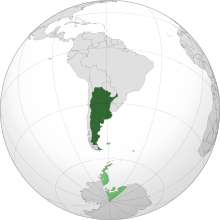 | |
| Total population | |
| Core Jewish population: 180,500[1] Enlarged Jewish population (includes non-Jewish relatives of Jews): 330,000[2] In Spain: Several thousand[4] | |
| Regions with significant populations | |
| Predominantly in Buenos Aires · Buenos Aires Province · Córdoba · Santa Fe · Entre Ríos · Tucumán | |
| Languages | |
| Predominantly Spanish. Some speak Hebrew, Yiddish, Arabic, Judaeo-Spanish, Russian, Polish or German. | |
| Religion | |
| Judaism · Jewish secularism |

| Part of a series on |
| Jews and Judaism |
|---|
The history of the Jews in Argentina goes back to the early sixteenth century, following the expulsion of Jews from Spain. Sephardic Jews fleeing persecution immigrated with explorers and colonists to settle in what is now Argentina,[5] in spite of being forbidden from travelling to the American colonies.[6] In addition, many of the Portuguese traders in the Viceroyalty of the Río de la Plata were Jewish. An organized Jewish community, however, did not develop until after Argentina gained independence from Spain in 1816. By mid-century, Jews from France and other parts of Western Europe, fleeing the social and economic disruptions of revolutions, began to settle in Argentina.[5][7] Argentines of both Ashkenazi and Sephardic heritage have left their mark on all aspects of Argentine culture, including in areas such as cuisine.[8]
Reflecting the composition of the later immigration waves, the current Jewish population is 80% Ashkenazi; while Sephardi and Mizrahi are a minority.[9] Argentina has the largest Jewish population of any country in Latin America, although numerous Jews left during the 1970s and 1980s to escape the repression of the military junta, emigrating to Israel, West Europe (especially Spain), and North America.[5]
The community numbered about 400,000 after World War II, but the appeal of Israel and economic and cultural pressures at home led many to leave; recent instability in Israel has resulted in a modest reversal of the trend since 2003.[10] During a major emigration wave in the 2000s, more than 10,000 Argentine Jews settled in Israel.
- ^ Cite error: The named reference
wjp2017was invoked but never defined (see the help page). - ^ DellaPergola, Sergio (2019), "World Jewish Population, 2018", in Dashefsky, Arnold; Sheskin, Ira M. (eds.), American Jewish Year Book 2018, American Jewish Year Book, vol. 118, Springer International Publishing, pp. 361–449, doi:10.1007/978-3-030-03907-3_8, ISBN 9783030039066, S2CID 146549764
- ^ Para ti. "Argentinos en Israel" (in Spanish). Archived from the original on 23 April 2016. Retrieved 20 March 2014.
- ^ Cnann Liphshiz. "Argentine immigrants fuel Jewish revival in Spain". Retrieved 11 December 2023.
- ^ a b c Weiner, Rebecca. "The Virtual Jewish History Tour – Argentina". Archived from the original on 15 June 2012. Retrieved 9 January 2008.
- ^ "El origen de los apellidos Borrero, Bejarano, Benaim y Turquía | Radio Sefarad" (in Spanish). Archived from the original on 16 October 2022. Retrieved 15 October 2022.
- ^ "Americas – Argentina; History". American Jewish Joint Distribution Committee. Archived from the original on 22 October 2007. Retrieved 9 January 2008.
- ^ Brodsky, Adriana. "This Is Not Your Gefilte Fish: Couscous, Cookbooks, and the Making of Modern Argentine-Sephardi Identity". Bridge to Argentina. Retrieved 29 May 2024.
- ^ LeElef, Ner. "World Jewish Population". Archived from the original on 17 May 2020. Retrieved 9 January 2008.
- ^ "Clarín". Clarin.com. 22 December 2003. Archived from the original on 7 July 2009. Retrieved 25 April 2010.